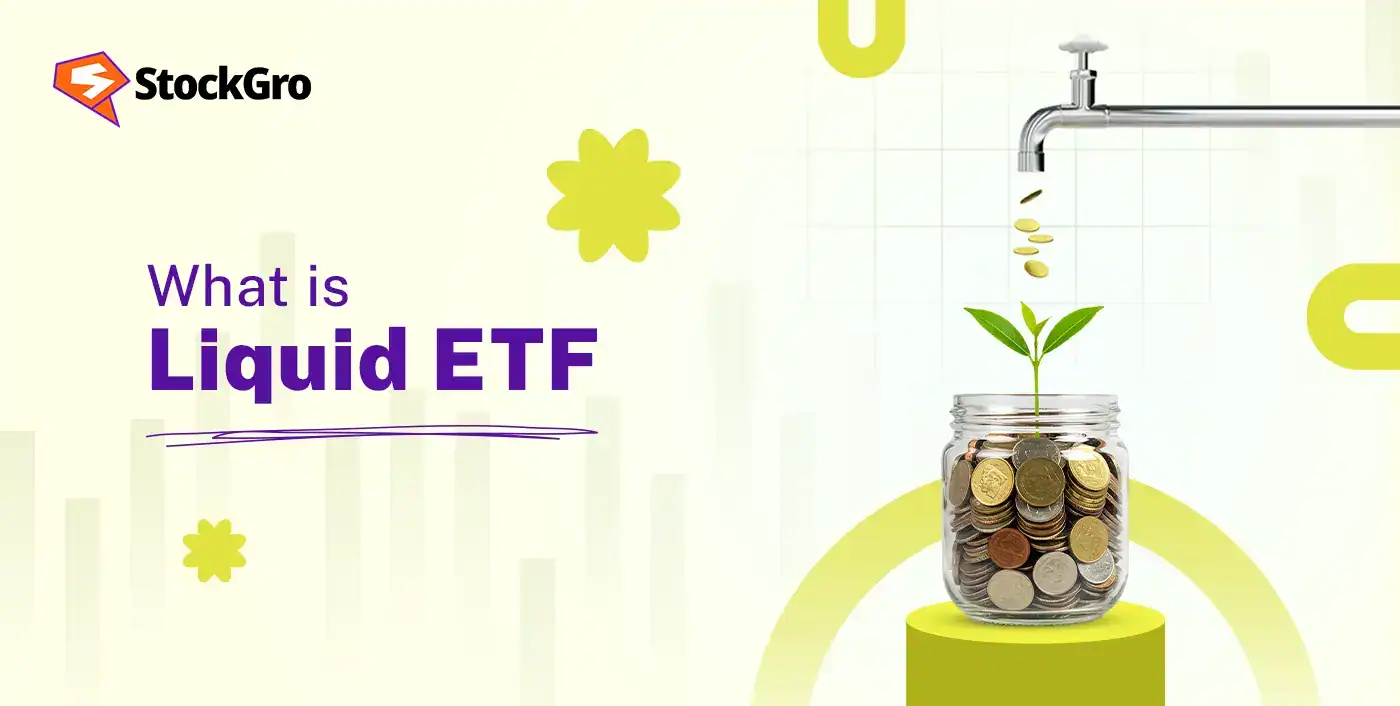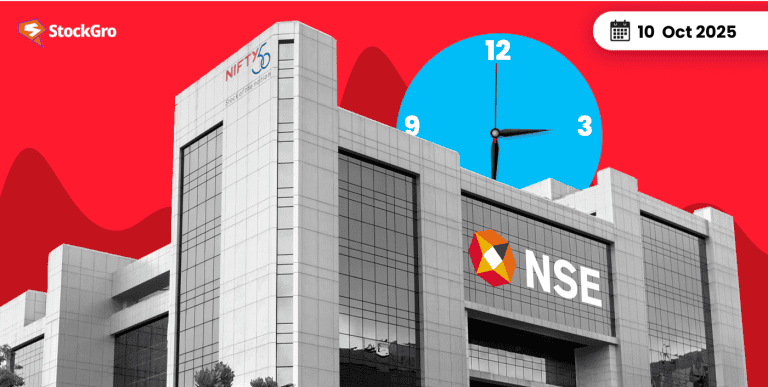
Managing short-term funds efficiently can be difficult for enterprises and traders who need both safety and accessibility. Seasonal businesses, startups awaiting receivables, and market participants handling margins often look for options that allow temporary parking of money without withdrawal limits. Liquid ETFs address this need by combining the stability of debt instruments with the flexibility of exchange trading. These funds invest in short-term, high-quality securities, making cash management more efficient. Evidence of their growing role, the AUM of liquid funds increased by 20.4%, from ₹3.63 lakh crore in March 2024 to ₹4.37 lakh crore in March 2025. This blog discusses what is a liquid ETF in detail, along with its benefits and more, to help you make the right investment choice.
What is a Liquid ETF?
A liquid ETF’s definition is simple. It’s a liquid exchange-traded fund (ETF), a type of debt instrument that invests in very short-term, low-risk money market securities, such as treasury bills and other assets with a one-day maturity period. These funds are traded on stock exchanges, like individual stocks, and are designed to offer a highly liquid investment option. The primary objective is to provide a safe avenue for parking surplus cash for a short duration, aiming for returns that are typically better than a standard savings account.
Key Features of Liquid ETFs
The primary characteristics that define a liquid ETF in India include the following:
- Intraday tradability: Units can be bought and sold on the stock exchange throughout trading hours, allowing for easy conversion to cash.
- Fundamental portfolio stability: They invest in high-quality, ultra-short-term securities like government bills and repo instruments, which minimise volatility and risk.
- Designed for transitory funds: These funds are specifically designed for investors looking to park funds for a very short period, often just a few days.
- Cost-efficient structure: Being passively managed instruments, the costs associated with managing a Liquid ETF are generally lower compared to other mutual funds.
- Regular portfolio disclosure: The portfolio holdings are disclosed regularly, providing investors with clear insight into where their money is invested.
How Liquid ETFs Work
Liquid ETFs function by pooling capital from numerous investors to purchase a portfolio of short-term money market instruments. An asset management company (AMC) creates the fund and then lists its units on a stock exchange, such as the National Stock Exchange (NSE) or BSE.
Investors can buy and sell these units at market prices during the trading day through their demat and trading accounts, similar to how they would trade a stock. When an investor sells a stock, for instance, the proceeds can be used to purchase units of a Liquid ETF on the same day. This ensures the money remains invested rather than sitting idle in a margin account. The fund manager handles the investment in underlying securities, and the returns generated are passed on to the investors.
Daily Dividends & NAV Handling
Another important feature of Liquid ETFs is their daily dividend distribution, which is governed by special operational rules. Every business day functions as both the record and ex-dividend date, and investors must purchase units before a specific cut-off time to be eligible for that day’s dividend. Income from the fund’s securities, less daily expenses, is declared as a dividend using the conceptual formula:
Daily Dividend per Unit = (Total Income from Securities – Daily Fund Expenses) ÷ Total Units Outstanding
Instead of a cash payout, this dividend is mandatorily reinvested to buy additional fractional units for the investor. This mechanism keeps the Net Asset Value (NAV) stable, and the accumulated units are not taxed daily; rather, the total capital gain is taxed upon sale.
Benefits of Liquid ETFs
The core Liquid ETF benefits include the following:
- Activating idle capital: They provide a way to earn returns on surplus cash that might otherwise remain idle in a savings or trading account between transactions.
- Collateral for trading margins: Many stockbrokers accept Liquid ETF units as collateral for providing trading margins, allowing investors to earn returns on their margin money.
- Economical fund management: Their structure as passively managed instruments generally results in lower expense ratios, which contributes to their overall cost efficiency.
- Spread of risk across instruments: By investing in a portfolio of different short-term securities, these funds offer inherent diversification, which helps in mitigating risk.
- Seamless transaction process: The process of buying and selling is straightforward for anyone with a demat account, simplifying the management of funds between a bank account and a trading account.
Liquid ETFs vs. Liquid Funds
While both are used for short-term cash management, there are fundamental differences between a liquid ETF vs liquid fund.
| Feature | Liquid ETF | Liquid fund |
| Structure | An exchange-traded fund whose units are traded on a stock exchange. | An open-ended debt mutual fund scheme. |
| Trading | Bought and sold on stock exchanges during market hours at real-time prices. | Purchased and redeemed via an AMC at the end-of-day NAV. |
| Account type | Requires a demat and trading account. | Does not require a demat account; can be held in a folio. |
| Liquidity | Intraday liquidity; can be sold anytime during trading hours. | Redemption requests are processed at the end of the day; funds are typically received the next business day (T+1). |
| Price/NAV | Price is determined by market demand and supply. | Price is the Net Asset Value (NAV) declared at the end of the trading day. |
| Returns | Returns are distributed as daily dividends, which are reinvested as additional units. | Returns are reflected in the growth of the NAV (for growth plans) or paid out as dividends. |
Use Cases in Trading & Cash Management
As we’ve mentioned previously in the blog, liquid ETFs are a good choice for parking surplus funds and for trading. Now let’s take an example to see how it really helps.
Anish is an informed equity investor who keeps around ₹5 lakh in his trading account, ready to buy stocks whenever a good opportunity arises. Most of this cash often sat idle for weeks between trades, earning very little.
He decided to quantify the opportunity cost of leaving his funds idle. His bank savings account offered about 3.5% annual return, which comes to roughly ₹48 per day on ₹5 lakh. Whereas, a popular Liquid ETF was giving around 7% annual return, which works out to about ₹96 per day on the same amount. By leaving money idle, he realised he was losing nearly half of the potential low-risk earnings every single day.
To fix this, Anish adopted a simple strategy. Whenever he sells a stock, he immediately puts the proceeds into the Liquid ETF. While waiting for the next stock opportunity, his ₹5 lakh earns a return close to 7%, almost double what his bank would have offered. When he finds a stock to buy, he sells the Liquid ETF units, and the funds are instantly available in his trading account, ready for trading without any delay.
By managing his idle funds this way, Anish effectively doubled the return on his cash. Over the course of a year, this approach adds thousands of rupees in extra earnings, all while keeping his money ready for trading whenever he wants.
Tax Implications of Liquid ETFs (India)
As of FY 2025-2026, Liquid ETF taxation treatment in India is governed as per the following rules:
- Short-term capital gains (STCG) on liquid ETFs (where the underlying assets are other than equity shares) are taxed at the income tax slabs.
- If units are held for one year or less, any gains are treated as short-term and taxed at the applicable income tax slabs.
- Long-term capital gains (LTCG) for holding units beyond one year are taxed at 12.5% without indexation benefit for transfers occurring on or after July 23, 2024.
- For transfers on or before July 22, 2024, the LTCG tax was 10% without indexation benefits.
- Tax treatment follows the classification of ETFs as listed securities where the underlying assets are other than equity shares.
- Dividends distributed by liquid ETFs are taxable in the hands of the unit holders as per their applicable slab rates.
Prominent Liquid ETFs in India
When looking for the best liquid ETF India has to offer, investors often compare returns to assess performance. The table below lists the top performers based on their returns as of 08-Oct-2025.
| ETF name | 1-month return (%) | 3-month return (%) | 6-month return (%) | 1-year return (%) |
| Kotak Nifty 1D Rate Liquid ETF | 0.43 | 1.31 | 2.68 | 5.91 |
| Zerodha Nifty 1D Rate Liquid ETF | 0.42 | 1.29 | 2.63 | 5.80 |
| DSP BSE Liquid Rate ETF | 0.42 | 1.28 | 2.62 | 5.78 |
| ICICI Pru BSE Liquid Rate ETF – IDCW | 0.42 | 1.28 | 2.61 | 5.78 |
| Groww Nifty 1D Rate LIQUID ETF | 0.40 | 1.25 | 2.54 | 5.74 |
Conclusion
To conclude, understanding what is a liquid ETF goes beyond its features, it’s about recognising its role as a strategic tool for financial agility. It acts as an important link between earning and investing, ensuring no part of your capital remains dormant. For the modern investor, it represents a foundational element for dynamic and efficient capital management.
FAQs
A liquid ETF is an exchange-traded fund that invests primarily in short-term debt instruments like treasury bills and certificates of deposit, emphasising high liquidity and safety. Unlike equity ETFs, which hold stocks, liquid ETFs focus on preserving capital with minimal volatility and easy accessibility for cash management.
In India, liquid ETFs provide investors with exposure to money market instruments through an exchange-traded structure. They trade on stock exchanges like stocks, offering liquidity with low expense ratios. These ETFs invest in short-duration government securities, commercial papers, and certificates of deposit, allowing investors to park funds temporarily with steady returns.
Liquid ETFs offer high liquidity and easy marketability, low risk due to investment in short-term instruments, low expense ratios compared to mutual funds, and quick accessibility to funds. They are ideal for investing surplus cash with better returns than savings accounts and provide diversification across low-risk debt securities.
Liquid ETFs trade on exchanges like stocks, allowing intraday buying and selling at market prices, while liquid mutual funds are bought or redeemed at the end-of-day NAV. ETFs often have lower expense ratios, tax efficiency, and greater transparency, whereas mutual funds may provide convenience with direct purchases and systematic investment options.
Yes, liquid ETF units are generally accepted as collateral by many brokers and exchanges for providing margin in trading. Their high liquidity and stable value make them suitable for margin requirements, enabling investors to leverage their holdings without selling units.
Daily dividends on ETFs are generally reinvested back into the fund, not paid out as cash. This means the dividend amount is used to purchase additional ETF units for investors, increasing their holdings automatically. The NAV typically remains stable as shares are added daily without cash payouts.
In India, from April 1, 2023, all capital gains from liquid ETFs classified as debt-oriented funds are taxed according to the investor’s income tax slab rate regardless of the holding period. This removes the previous distinction between short-term and long-term capital gains for these ETFs.

